Parsing documents with AI_PARSE_DOCUMENT¶
AI_PARSE_DOCUMENT ist eine Cortex-AI-SQL-Funktion, die Text, Daten und Layoutelemente aus Dokumenten mit hoher Genauigkeit extrahiert. Verwenden Sie diese Funktion, um intelligente Dokumentenverarbeitungs-Workflows zu unterstützen, darunter:
RAG-Pipeline-Optimierung: Die Extraktion mit hoher Genauigkeit stellt sicher, dass Abrufsysteme relevante Inhalte mit dem richtigen Kontext finden, was die Antwortqualität erheblich verbessert.
Aufbau von Wissensdatenbanken: Eine strukturierte Ausgabe ermöglicht die semantische Suche und AI-Logik über große Dokumentensammlungen hinweg.
Automated document processing: Extract entities, generate summaries, and perform analysis on complex documents using other Cortex AI Functions.
Mehrsprachige AI-Workflows: Verarbeiten Dokumente in zwölf Sprachen mit konsistenter Qualität für globale Unternehmensanwendungen.
AI_PARSE_DOCUMENT¶
AI_PARSE_DOCUMENT is a fully managed SQL function that extracts text and layout from documents stored on internal or external stages, preserving structure like tables, headers, and reading order. See Create stage for media files for information on creating a stage suitable for storing documents.
Under the hood, AI_PARSE_DOCUMENT orchestrates advanced AI models for document understanding and layout analysis, processing complex multi-page documents with high fidelity.
Die Funktion AI_PARSE_DOCUMENT bietet zwei Modi für die Verarbeitung von PDF-Dokumenten:
Der LAYOUT-Modus ist die bevorzugte Wahl für die meisten Anwendungsfälle, insbesondere bei komplexen Dokumenten. Der Modus ist speziell für das Extrahieren von Text und Layoutelementen wie Tabellen optimiert, was ihn zur besten Option für den Aufbau von Wissensdatenbanken, die Optimierung von Abrufsystemen und die Verbesserung AI-basierter Anwendungen macht.
Der OCR-Modus wird für eine schnelle, hochwertige Textextraktion aus Dokumenten wie Handbüchern, Vereinbarungen oder Verträgen, Produktdetailseiten, Versicherungspolicen und -ansprüchen sowie SharePoint-Dokumenten empfohlen.
Verwenden Sie für beide Modi die Option page_split, um mehrseitige Dokumente in der Antwort in separate Seiten aufzuteilen. Sie können auch die Option page_filter verwenden, um nur bestimmte Seiten zu verarbeiten. (Bei Verwendung von page_filter ist page_split impliziert, das heißt, Sie müssen dies nicht explizit festlegen.)
AI_PARSE_DOCUMENT ist horizontal skalierbar und ermöglicht eine effiziente Batch-Verarbeitung mehrere Dokumente gleichzeitig. Dokumente können direkt aus dem Objektspeicher verarbeitet werden, um unnötige Datenbewegungen zu vermeiden.
Bemerkung
AI_PARSE_DOCUMENT ist derzeit nicht mit den benutzerdefinierten von Netzwerkrichtlinien kompatibel.
Beispiele¶
Einfaches Layoutbeispiel¶
Bei diesem Beispiel wird der LAYOUT-Modus von AI_PARSE_DOCUMENT verwendet, um eine zweispaltige Forschungsarbeit zu verarbeiten. Der Parameter page_split ist auf TRUE festgelegt, um das Dokument in der Antwort in Seiten aufzuteilen. AI_PARSE_DOCUMENT gibt den Inhalt im Markdown-Format zurück. Im Folgenden sehen Sie das gerenderte Markdown für eine der verarbeiteten Seiten (Seitenindex 4 in der JSON-Ausgabe) neben der ursprünglichen Seite. Das rohe Markdown wird in der JSON-Antwort nach den Bildern angezeigt.
Seite aus dem ursprünglichen Dokument |
Extrahiertes Markdown, gerendert als HTML |
|---|---|
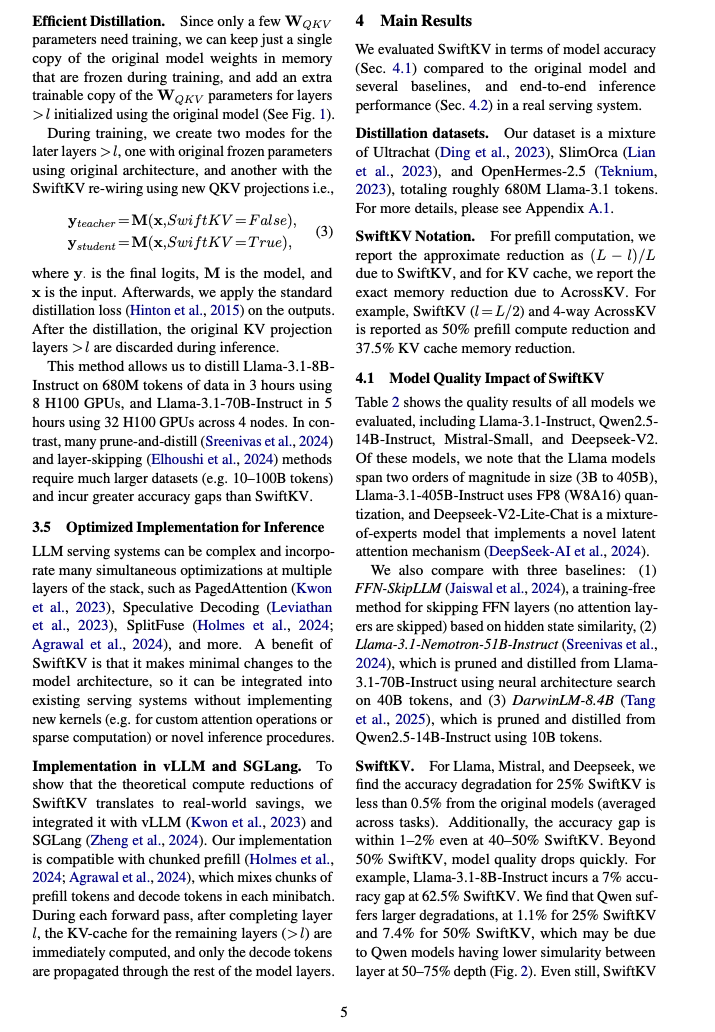
|
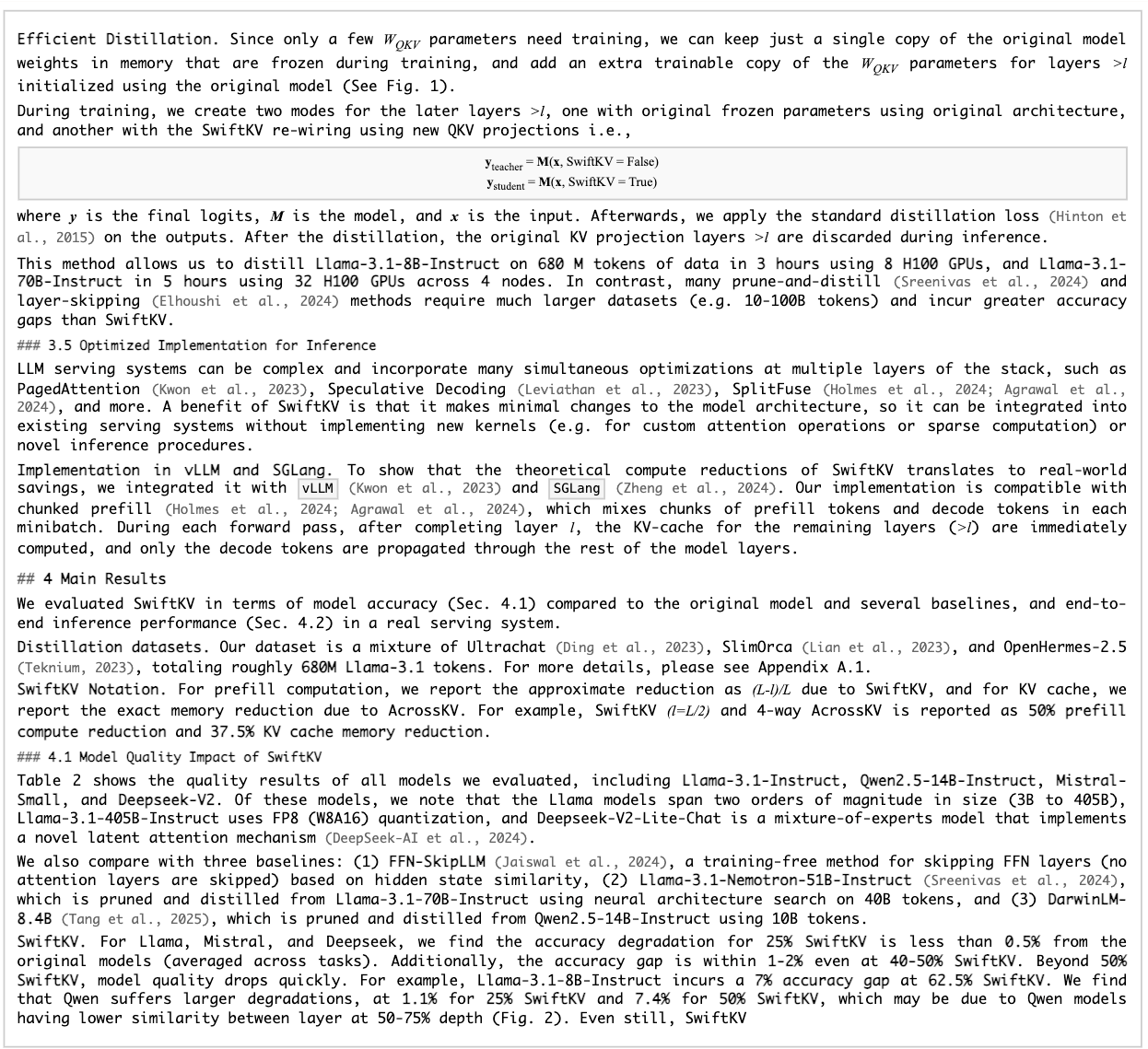
|
Tipp
Um eines dieser Bilder in einer besser lesbaren Größe anzuzeigen, wählen Sie es durch Klicken oder Tippen aus.
Im Folgenden sehen Sie den SQL-Befehl zur Verarbeitung des ursprünglichen Dokuments:
SELECT AI_PARSE_DOCUMENT (
TO_FILE('@docs.doc_stage','research-paper-example.pdf'),
{'mode': 'LAYOUT' , 'page_split': true}) AS research_paper_example;
Die Antwort von AI_PARSE_DOCUMENT ist ein JSON-Objekt, das Metadaten und Text von den Seiten des Dokuments enthält, wie im Folgenden. Einige Objekte der Seite wurden der Kürze halber weggelassen.
{
"metadata": {
"pageCount": 19
},
"pages": [
{
"content": "# SwiftKV: Fast Prefill-Optimized Inference with Knowledge-Preserving Model Transformation \n\nAurick Qiao
Zhewei Yao Samyam Rajbhandari Yuxiong He<br>Snowflake AI Research<br>San Mateo, CA, United States<br>Correspondence:
aurick.qiao@ snowflake.com\n\n\n#### Abstract\n\nLLM inference for enterprise applications, such as summarization, RAG,
and code-generation, typically observe much longer prompt than generations, leading to high prefill cost and response
latency. We present SwiftKV, a novel model transformation and distillation procedure targeted at reducing the prefill
compute (in FLOPs) of prompt tokens while preserving high generation quality. First, SwiftKV prefills later layers' KV
cache using an earlier layer's output, allowing prompt tokens to skip those later layers. Second, SwiftKV employs a
lightweight knowledge-preserving distillation procedure that can adapt existing LLMs with minimal accuracy impact. Third,
SwiftKV can naturally incorporate KV cache compression to improve inference performance in low-memory scenarios. Our
comprehensive experiments show that SwiftKV can effectively reduce prefill computation by $25-50 \\%$ across several LLM
families while incurring minimum quality degradation. In the end-to-end inference serving, SwiftKV realizes up to $2
\\times$ higher aggregate throughput and $60 \\%$ lower time per output token. It can achieve a staggering 560 TFlops/GPU
of normalized inference throughput, which translates to 16 K tokens/s for Llama-3.1-70B. SwiftKV is open-sourced at
https://github . com/snowflakedb/arctictraining.\n\n\n## 1 Introduction\n\nLarge Language Models (LLMs) are now an
integral enabler of enterprise applications and offerings, including code and data co-pilots (Chen et al., 2021; Pourreza
and Rafiei, 2024), retrieval augmented generation (RAG) (Lewis et al., 2020; Lin et al., 2024), summarization (Pu et al.,
2023; Zhang et al., 2024), and agentic workflows (Wang et al., 2024; Schick et al., 2023). However, the cost and speed of
inference determine their practicality, and improving the throughput and latency of LLM inference has become increasingly
important.\n\nWhile prior works, such as model pruning (Ma et al., 2023; Sreenivas et al., 2024), KV cache compression
(Hooper et al., 2024; Shazeer, 2019; Ainslie et al., 2023b; Chang et al., 2024), and sparse attention (Zhao et al., 2024;
Jiang et al., 2024), have been developed to accelerate LLM inference, they typically significantly degrade the model
quality or work best in niche scenarios, such as lowmemory environments or extremely long contexts requests (e.g. $>100
\\mathrm{~K}$ tokens). On the other hand, production deployments are often compute-bound rather than memory-bound, and
such long-context requests are rare amongst diverse enterprise use cases (e.g. those observed at Snowflake).\n\nIn this
paper, we take a different approach to improving LLM inference based on the key observation that typical enterprise
workloads process more input tokens than output tokens. For example, tasks like code completion, text-to-SQL,
summarization, and RAG each submit long prompts but produce fewer output tokens (a 10:1 ratio with average prompt length
between 500 and 1000 is observed in our production). In these scenarios, inference throughput and latency are often
dominated by the cost of prompt processing (i.e. prefill), and reducing this cost is key to improving their performance.
\n\nBased on this observation, we designed SwiftKV, which improves throughput and latency by reducing the prefill
computation for prompt tokens. SwiftKV (Fig. 1) consists of three key components:\n\nModel transformation. SwiftKV rewires
an existing LLM so that the prefill stage during inference can skip a number of later transformer layers, and their KV
cache are computed by the last unskipped layer. This is motivated by the observation that the hidden states of later
layers do not change significantly (see Sec. 3.2 and (Liu et al., 2024b)). With SwiftKV, prefill compute is reduced by
approximately the number of layers skipped.\n\nOptionally, for low-memory scenarios, we",
"index": 0
},
...
{
"content": "Efficient Distillation. Since only a few $\\mathbf{W}_{Q K V}$ parameters need training, we can keep just a
single copy of the original model weights in memory that are frozen during training, and add an extra trainable copy of
the $\\mathbf{W}_{Q K V}$ parameters for layers $>l$ initialized using the original model (See Fig. 1).\n\nDuring
training, we create two modes for the later layers $>l$, one with original frozen parameters using original architecture,
and another with the SwiftKV re-wiring using new QKV projections i.e.,\n\n$$\n\\begin{aligned}\n& \\mathbf{y}_{\\text
{teacher }}=\\mathbf{M}(\\mathbf{x}, \\text { SwiftKV }=\\text { False }) \\\\\n& \\mathbf{y}_{\\text {student }}=\\mathbf
{M}(\\mathbf{x}, \\text { SwiftKV }=\\text { True })\n\\end{aligned}\n$$\n\nwhere $\\mathbf{y}$ is the final logits,
$\\mathbf{M}$ is the model, and $\\mathbf{x}$ is the input. Afterwards, we apply the standard distillation loss (Hinton et
al., 2015) on the outputs. After the distillation, the original KV projection layers $>l$ are discarded during inference.
\n\nThis method allows us to distill Llama-3.1-8BInstruct on 680 M tokens of data in 3 hours using 8 H100 GPUs, and
Llama-3.1-70B-Instruct in 5 hours using 32 H100 GPUs across 4 nodes. In contrast, many prune-and-distill (Sreenivas et
al., 2024) and layer-skipping (Elhoushi et al., 2024) methods require much larger datasets (e.g. 10-100B tokens) and incur
greater accuracy gaps than SwiftKV.\n\n### 3.5 Optimized Implementation for Inference\n\nLLM serving systems can be
complex and incorporate many simultaneous optimizations at multiple layers of the stack, such as PagedAttention (Kwon et
al., 2023), Speculative Decoding (Leviathan et al., 2023), SplitFuse (Holmes et al., 2024; Agrawal et al., 2024), and
more. A benefit of SwiftKV is that it makes minimal changes to the model architecture, so it can be integrated into
existing serving systems without implementing new kernels (e.g. for custom attention operations or sparse computation) or
novel inference procedures.\n\nImplementation in vLLM and SGLang. To show that the theoretical compute reductions of
SwiftKV translates to real-world savings, we integrated it with vLLM (Kwon et al., 2023) and SGLang (Zheng et al., 2024).
Our implementation is compatible with chunked prefill (Holmes et al., 2024; Agrawal et al., 2024), which mixes chunks of
prefill tokens and decode tokens in each minibatch. During each forward pass, after completing layer $l$, the KV-cache for
the remaining layers ( $>l$ ) are immediately computed, and only the decode tokens are propagated through the rest of the
model layers.\n\n## 4 Main Results\n\nWe evaluated SwiftKV in terms of model accuracy (Sec. 4.1) compared to the original
model and several baselines, and end-to-end inference performance (Sec. 4.2) in a real serving system.\n\nDistillation
datasets. Our dataset is a mixture of Ultrachat (Ding et al., 2023), SlimOrca (Lian et al., 2023), and OpenHermes-2.5
(Teknium, 2023), totaling roughly 680M Llama-3.1 tokens. For more details, please see Appendix A.1.\n\nSwiftKV Notation.
For prefill computation, we report the approximate reduction as $(L-l) / L$ due to SwiftKV, and for KV cache, we report
the exact memory reduction due to AcrossKV. For example, SwiftKV $(l=L / 2)$ and 4-way AcrossKV is reported as $50 \\%$
prefill compute reduction and $37.5 \\% \\mathrm{KV}$ cache memory reduction.\n\n### 4.1 Model Quality Impact of
SwiftKV\n\nTable 2 shows the quality results of all models we evaluated, including Llama-3.1-Instruct, Qwen2.
5-14B-Instruct, Mistral-Small, and Deepseek-V2. Of these models, we note that the Llama models span two orders of
magnitude in size (3B to 405B), Llama-3.1-405B-Instruct uses FP8 (W8A16) quantization, and Deepseek-V2-Lite-Chat is a
mixture-of-experts model that implements a novel latent attention mechanism (DeepSeek-AI et al., 2024).\n\nWe also compare
with three baselines: (1) FFN-SkipLLM (Jaiswal et al., 2024), a training-free method for skipping FFN layers (no attention
layers are skipped) based on hidden state similarity, (2) Llama-3.1-Nemotron-51B-Instruct (Sreenivas et al., 2024), which
is pruned and distilled from Llama-3.1-70B-Instruct using neural architecture search on 40B tokens, and (3) DarwinLM-8.4B
(Tang et al., 2025), which is pruned and distilled from Qwen2.5-14B-Instruct using 10B tokens.\n\nSwiftKV. For Llama,
Mistral, and Deepseek, we find the accuracy degradation for $25 \\%$ SwiftKV is less than $0.5 \\%$ from the original
models (averaged across tasks). Additionally, the accuracy gap is within $1-2 \\%$ even at $40-50 \\%$ SwiftKV. Beyond $50
\\%$ SwiftKV, model quality drops quickly. For example, Llama-3.1-8B-Instruct incurs a 7\\% accuracy gap at $62.5 \\%$
SwiftKV. We find that Qwen suffers larger degradations, at $1.1 \\%$ for $25 \\%$ SwiftKV and $7.4 \\%$ for $50 \\%$
SwiftKV, which may be due to Qwen models having lower simularity between layer at 50-75\\% depth (Fig. 2). Even still,
SwiftKV",
"index": 4
},
...
]
}
Beispiel für das Extrahieren einer Tabellenstruktur¶
Dieses Beispiel zeigt das Extrahieren eines strukturellen Layouts, einschließlich einer Tabelle, aus einem 10-K-Bericht. Im Folgenden werden die gerenderten Ergebnisse für eine der verarbeiteten Seiten angezeigt (Seitenindex 28 in der JSON-Ausgabe).
Seite aus dem ursprünglichen Dokument |
Extrahiertes Markdown, gerendert als HTML |
|---|---|
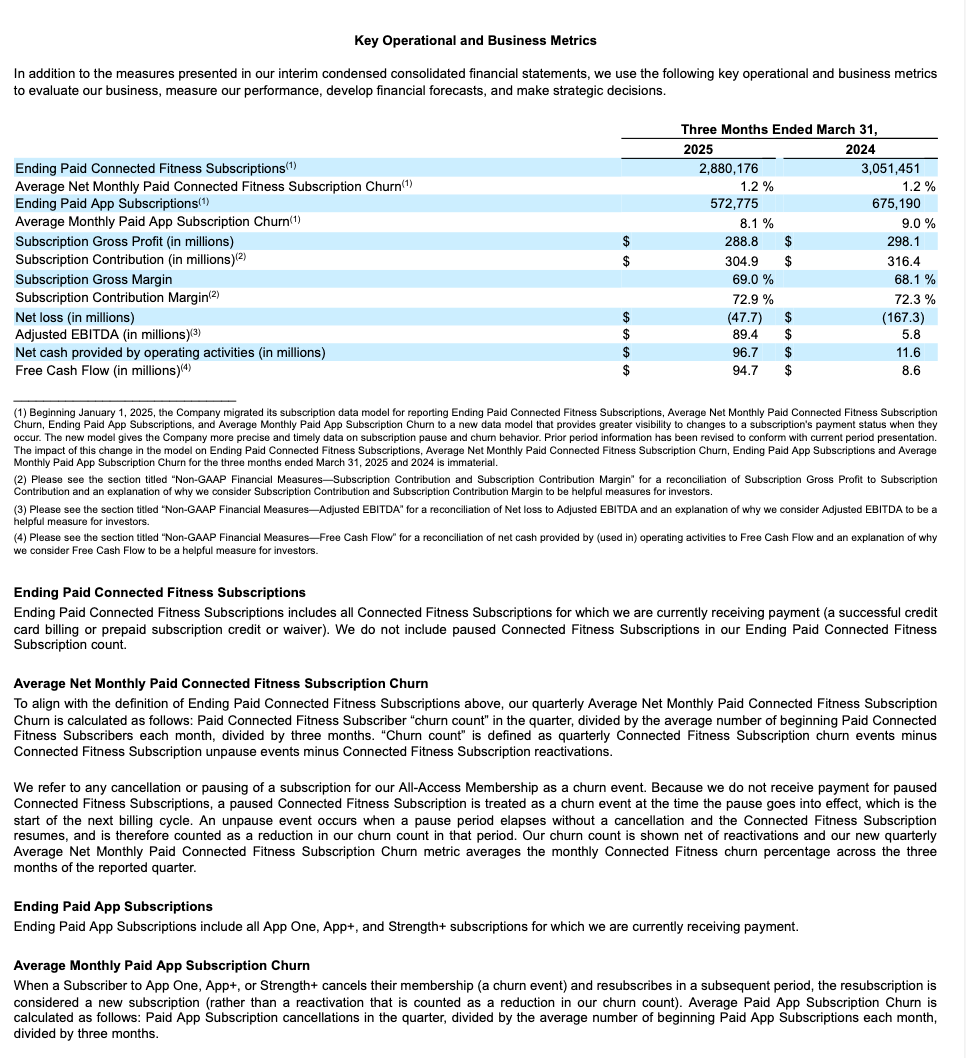
|
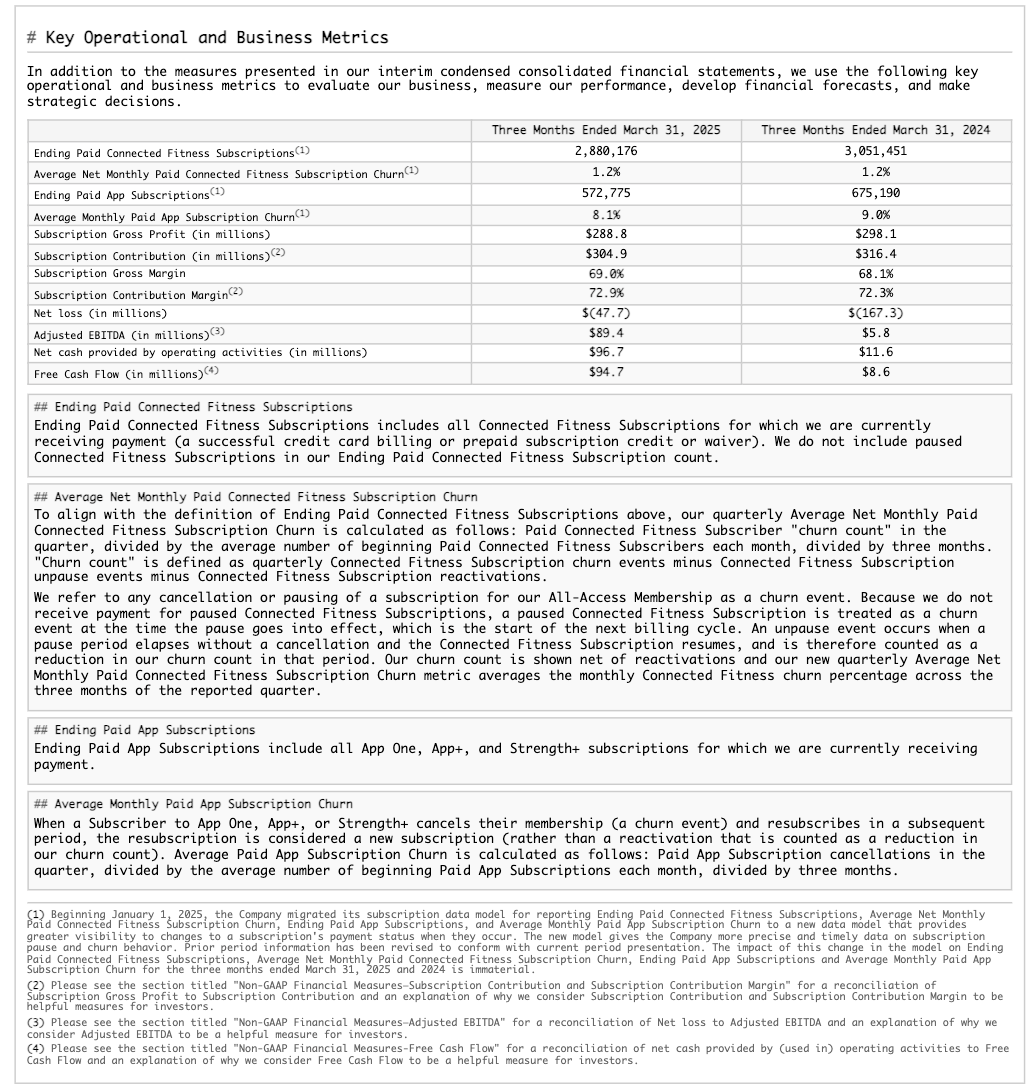
|
Tipp
Um eines dieser Bilder in einer besser lesbaren Größe anzuzeigen, wählen Sie es durch Klicken oder Tippen aus.
Im Folgenden sehen Sie den SQL-Befehl zur Verarbeitung des ursprünglichen Dokuments:
SELECT AI_PARSE_DOCUMENT (
TO_FILE('@docs.doc_stage','10K-example.pdf'),
{'mode': 'LAYOUT', 'page_split': true}) AS sec_10k_example;
Die Antwort von AI_PARSE_DOCUMENT ist ein JSON-Objekt, das Metadaten und Text von den Seiten des Dokuments enthält, wie im Folgenden. Die Ergebnisse für alle bis auf die zuvor gezeigte Seite wurden der Kürze halber weggelassen.
{
"metadata": {
"pageCount": 53
},
"pages": [
{
"content": ...
"index": 0
},
....
{
"content": "# Key Operational and Business Metrics \n\nIn addition to the measures presented in our interim condensed
consolidated financial statements, we use the following key operational and business metrics to evaluate our business,
measure our performance, develop financial forecasts, and make strategic decisions.\n\n| | Three Months Ended March 31, | |
\n| :--: | :--: | :--: |\n| | 2025 | 2024 |\n| Ending Paid Connected Fitness Subscriptions ${ }^{(1)}$ | 2,880,176 | $3,051,
451$ |\n| Average Net Monthly Paid Connected Fitness Subscription Churn ${ }^{(1)}$ | $1.2 \\%$ | $1.2 \\%$ |\n| Ending Paid
App Subscriptions ${ }^{(1)}$ | 572,775 | 675,190 |\n| Average Monthly Paid App Subscription Churn ${ }^{(1)}$ | $8.1 \\%$ |
$9.0 \\%$ |\n| Subscription Gross Profit (in millions) | \\$ 288.8 | \\$ 298.1 |\n| Subscription Contribution (in millions) $
{ }^{(2)}$ | \\$ 304.9 | \\$ 316.4 |\n| Subscription Gross Margin | $69.0 \\%$ | $68.1 \\%$ |\n| Subscription Contribution
Margin ${ }^{(2)}$ | $72.9 \\%$ | $72.3 \\%$ |\n| Net loss (in millions) | \\$ $(47.7)$ | \\$ $(167.3)$ |\n| Adjusted EBITDA
(in millions) ${ }^{(3)}$ | \\$ 89.4 | \\$ 5.8 |\n| Net cash provided by operating activities (in millions) | \\$ 96.7 | \\$
11.6 |\n| Free Cash Flow (in millions) ${ }^{(4)}$ | \\$ 94.7 | \\$ 8.6 |\n\n[^0]\n## Ending Paid Connected Fitness
Subscriptions\n\nEnding Paid Connected Fitness Subscriptions includes all Connected Fitness Subscriptions for which we are
currently receiving payment (a successful credit card billing or prepaid subscription credit or waiver). We do not include
paused Connected Fitness Subscriptions in our Ending Paid Connected Fitness Subscription count.\n\n## Average Net Monthly
Paid Connected Fitness Subscription Churn\n\nTo align with the definition of Ending Paid Connected Fitness Subscriptions
above, our quarterly Average Net Monthly Paid Connected Fitness Subscription Churn is calculated as follows: Paid Connected
Fitness Subscriber \"churn count\" in the quarter, divided by the average number of beginning Paid Connected Fitness
Subscribers each month, divided by three months. \"Churn count\" is defined as quarterly Connected Fitness Subscription
churn events minus Connected Fitness Subscription unpause events minus Connected Fitness Subscription reactivations.\n\nWe
refer to any cancellation or pausing of a subscription for our All-Access Membership as a churn event. Because we do not
receive payment for paused Connected Fitness Subscriptions, a paused Connected Fitness Subscription is treated as a churn
event at the time the pause goes into effect, which is the start of the next billing cycle. An unpause event occurs when a
pause period elapses without a cancellation and the Connected Fitness Subscription resumes, and is therefore counted as a
reduction in our churn count in that period. Our churn count is shown net of reactivations and our new quarterly Average Net
Monthly Paid Connected Fitness Subscription Churn metric averages the monthly Connected Fitness churn percentage across the
three months of the reported quarter.\n\n## Ending Paid App Subscriptions\n\nEnding Paid App Subscriptions include all App
One, App+, and Strength+ subscriptions for which we are currently receiving payment.\n\n## Average Monthly Paid App
Subscription Churn\n\nWhen a Subscriber to App One, App+, or Strength+ cancels their membership (a churn event) and
resubscribes in a subsequent period, the resubscription is considered a new subscription (rather than a reactivation that is
counted as a reduction in our churn count). Average Paid App Subscription Churn is calculated as follows: Paid App
Subscription cancellations in the quarter, divided by the average number of beginning Paid App Subscriptions each month,
divided by three months.\n\n\n[^0]: (1) Beginning January 1, 2025, the Company migrated its subscription data model for
reporting Ending Paid Connected Fitness Subscriptions, Average Net Monthly Paid Connected Fitness Subscription Churn, Ending
Paid App Subscriptions, and Average Monthly Paid App Subscription Churn to a new data model that provides greater visibility
to changes to a subscription's payment status when they occur. The new model gives the Company more precise and timely data
on subscription pause and churn behavior. Prior period information has been revised to conform with current period
presentation. The impact of this change in the model on Ending Paid Connected Fitness Subscriptions, Average Net Monthly
Paid Connected Fitness Subscription Churn, Ending Paid App Subscriptions and Average Monthly Paid App Subscription Churn for
the three months ended March 31, 2025 and 2024 is immaterial.\n (2) Please see the section titled \"Non-GAAP Financial
Measures—Subscription Contribution and Subscription Contribution Margin\" for a reconciliation of Subscription Gross Profit
to Subscription Contribution and an explanation of why we consider Subscription Contribution and Subscription Contribution
Margin to be helpful measures for investors.\n (3) Please see the section titled \"Non-GAAP Financial Measures—Adjusted
EBITDA\" for a reconciliation of Net loss to Adjusted EBITDA and an explanation of why we consider Adjusted EBITDA to be a
helpful measure for investors.\n (4) Please see the section titled \"Non-GAAP Financial Measures-Free Cash Flow\" for a
reconciliation of net cash provided by (used in) operating activities to Free Cash Flow and an explanation of why we
consider Free Cash Flow to be a helpful measure for investors.",
"index": 28
},
...
{
"content": "# CERTIFICATION OF PRINCIPAL FINANCIAL OFFICER PURSUANT TO 18 U.S.C. SECTION 1350, AS ADOPTED PURSUANT TO
SECTION 906 OF THE SARBANES-OXLEY ACT OF 2002 \n\nI, Elizabeth F Coddington, Chief Financial Officer of Peloton Interactive,
Inc. (the \"Company\"), do hereby certify, pursuant to 18 U.S.C. Section 1350, as adopted pursuant to Section 906 of the
Sarbanes-Oxley Act of 2002, that to the best of my knowledge:\n\n1. the Quarterly Report on Form 10-Q of the Company for the
fiscal quarter ended March 31, 2025 (the \"Report\") fully complies with the requirements of Section 13(a) or 15(d) of the
Securities Exchange Act of 1934, as amended; and\n2. the information contained in the Report fairly presents, in all
material respects, the financial condition, and results of operations of the Company.\n\nDate: May 8, 2025\n\nBy: /s/
Elizabeth F Coddington\nElizabeth F Coddington\nChief Financial Officer\n(Principal Financial Officer)",
"index": 52
}
]
}
Beispiel für eine Präsentation¶
Dieses Beispiel zeigt das Extrahieren eines strukturellen Layouts aus einer Präsentation. Unten sehen Sie die gerenderten Ergebnisse für eine der verarbeiteten Folien (Seitenindex 17 in der JSON-Ausgabe).
Folie aus dem ursprünglichen Dokument |
Extrahiertes Markdown, gerendert als HTML |
|---|---|
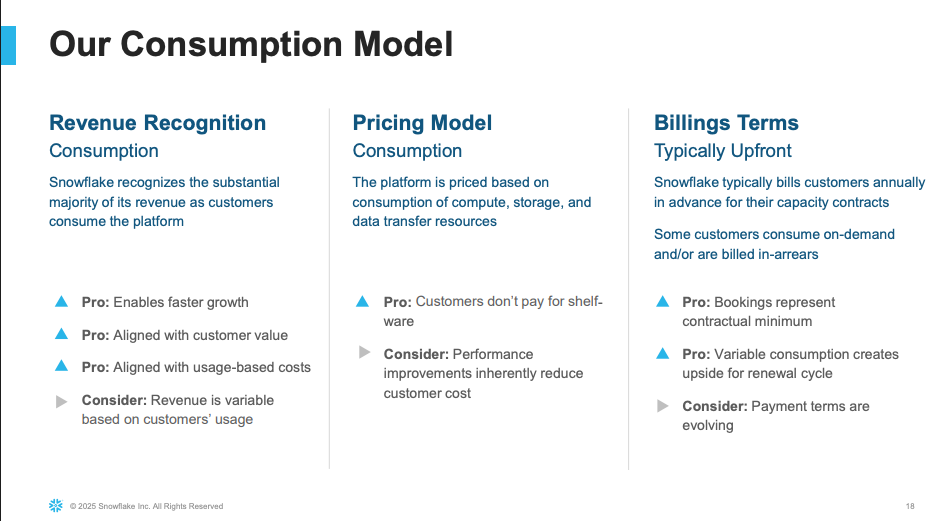
|
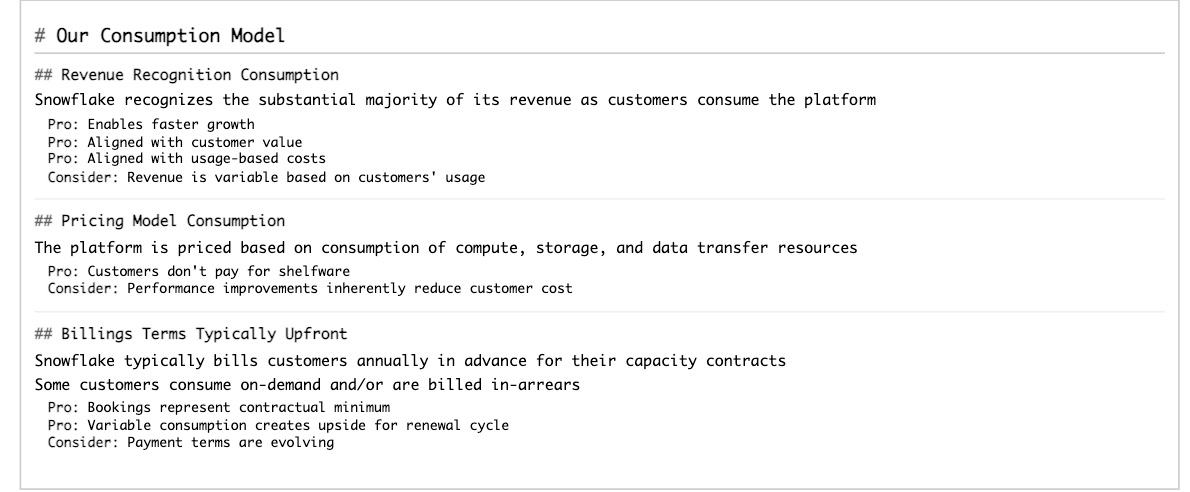
|
Tipp
Um eines dieser Bilder in einer besser lesbaren Größe anzuzeigen, wählen Sie es durch Klicken oder Tippen aus.
Im Folgenden sehen Sie den SQL-Befehl zur Verarbeitung des ursprünglichen Dokuments:
SELECT AI_PARSE_DOCUMENT (TO_FILE('@docs.doc_stage','presentation.pptx'),
{'mode': 'LAYOUT' , 'page_split': true}) as presentation_output;
Die Antwort von AI_PARSE_DOCUMENT ist ein JSON-Objekt, das Metadaten und den Text aus den Folien der Präsentationen enthält, wie im Folgenden. Die Ergebnisse einiger Folien wurden der Kürze halber weggelassen.
{
"metadata": {
"pageCount": 38
},
"pages": [
{
"content": "\n\n# **SNOWFLAKE INVESTOR PRESENTATION**\n\nFirst Quarter Fiscal 2026\n\n© 2026 Snowflake Inc. All Rights Reserved",
"index": 0
},
...
{
"content": "# Our Consumption Model \n\n## Revenue Recognition Consumption\n\nSnowflake recognizes the substantial majority of its revenue as customers consume the platform\n\nPro: Enables faster growth\nPro: Aligned with customer value\nPro: Aligned with usage-based costs\nConsider: Revenue is variable based on customers' usage\n\n## Pricing Model Consumption\n\nThe platform is priced based on consumption of compute, storage, and data transfer resources\n\nPro: Customers don't pay for shelfware\n\nConsider: Performance improvements inherently reduce customer cost\n\n## Billings Terms Typically Upfront\n\nSnowflake typically bills customers annually in advance for their capacity contracts\n\nSome customers consume on-demand and/or are billed in-arrears\n\nPro: Bookings represent contractual minimum\n\nPro: Variable consumption creates upside for renewal cycle\n\nConsider: Payment terms are evolving",
"index": 17
},
...
{
"content": "\n\n# PRODUCT REVENUE\n\n## $996.8M + 26% YoY Growth\n\n## NET REVENUE RETENTION RATE\n\n## $124%\n\n## TOTAL CUSTOMERS\n\n## $1M+ CUSTOMERS\n\n## $0.5 + 27% YoY Growth\n\nCustomers with Trailing 12-Month Product Revenue Greater than $1M\n\n## FORBES GLOBAL 2000 CUSTOMERS\n\n## $754 + 4% YoY Growth\n\n## SNOWFLAKE MARKETPLACE LISTINGS\n\n## AI/ML ADOPTION\n\n## 5,200+ Accounts using Snowflake AI/ML\n\n## SNOWFLAKE AI DATA CLOUD\n\n### Unified Platform and Connected Ecosystem\n\n- **Data Engineering**\n- **Analytics**\n- **AI**\n- **Applications & Collaboration**\n\n### Fully Managed | Cross-Cloud | Interoperable | Secure | Governed\n\n1. For the three months ended April 30, 2025.\n2. As of April 30, 2025. Please see our Q1FY26 earnings press release for definitions of net revenue retention rate, customers with trailing 12-month product revenue greater than $1 million (which definition includes a description of our total customer count), and Forbes Global 2000 customers.\n3. As of April 30, 2025. Each live dataset, package of datasets, or data service published by a data provider as a single product offering on Snowflake Marketplace is counted as a unique listing. A listing may be available in one or more regions where Snowflake Marketplace is available.\n4. Adoption is based on capacity and on-demand accounts using Snowflake AI/ML features on a weekly basis via our internal classification. We take the average of the last 4 weeks of the quarter ended April 30, 2025.",
"index": 36
},
{
"content": "# THANK YOU\n\n",
"index": 37
}
]
}
Beispiel für ein mehrsprachiges Dokument¶
Dieses Beispiel zeigt die AI_PARSE_DOCUMENT-Funktionen zur Mehrsprachigkeit, indem das strukturelle Layout aus einem deutschen Artikel extrahiert wird. AI_PARSE_DOCUMENT behält die Lesereihenfolge des Haupttextes bei, auch wenn Bilder und Zitate vorhanden sind.
Seite aus dem ursprünglichen Dokument |
Extrahiertes Markdown, gerendert als HTML |
|---|---|

|
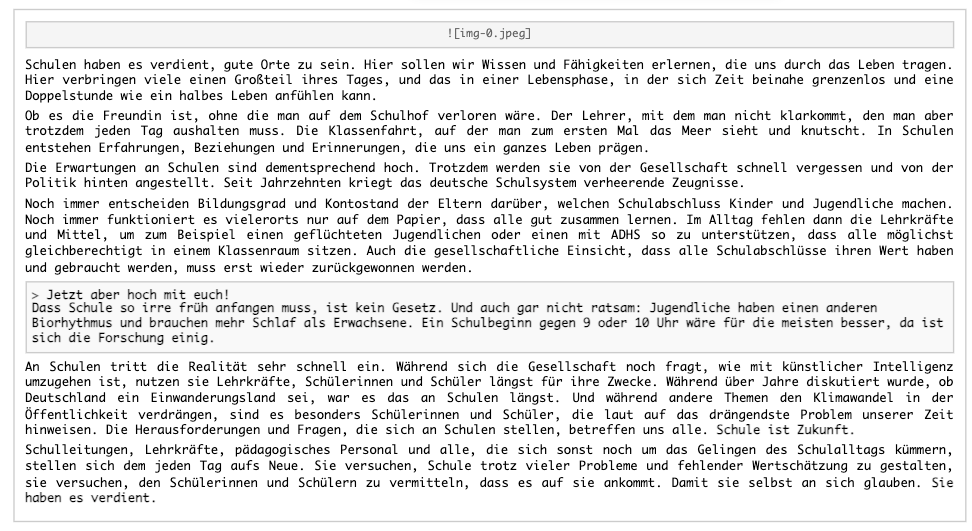
|
Tipp
Um eines dieser Bilder in einer besser lesbaren Größe anzuzeigen, wählen Sie es durch Klicken oder Tippen aus.
Im Folgenden sehen Sie den SQL-Befehl zur Verarbeitung des ursprünglichen Dokuments. Da das Dokument eine einzige Seite hat, ist für dieses Beispiel keine Seitenaufteilung erforderlich.
SELECT AI_PARSE_DOCUMENT (TO_FILE('@docs.doc_stage','german_example.pdf'),
{'mode': 'LAYOUT'}) AS german_article;
Die Antwort von AI_PARSE_DOCUMENT ist ein JSON-Objekt, das Metadaten und den Text aus dem Dokument enthält, wie im Folgenden.
{
"metadata": {
"pageCount": 1
}
"content": "\n\nSchulen haben es verdient, gute Orte zu sein. Hier sollen wir Wissen und Fähigkeiten
erlernen, die uns durch das Leben tragen. Hier verbringen viele einen Großteil ihres Tages, und das in einer Lebensphase, in
der sich Zeit beinahe grenzenlos und eine Doppelstunde wie ein halbes Leben anfühlen kann.\n\nOb es die Freundin ist, ohne die
man auf dem Schulhof verloren wäre. Der Lehrer, mit dem man nicht klarkommt, den man aber trotzdem jeden Tag aushalten muss.
Die Klassenfahrt, auf der man zum ersten Mal das Meer sieht und knutscht. In Schulen entstehen Erfahrungen, Beziehungen und
Erinnerungen, die uns ein ganzes Leben prägen.\n\nDie Erwartungen an Schulen sind dementsprechend hoch. Trotzdem werden sie
von der Gesellschaft schnell vergessen und von der Politik hinten angestellt. Seit Jahrzehnten kriegt das deutsche Schulsystem
verheerende Zeugnisse.\n\nNoch immer entscheiden Bildungsgrad und Kontostand der Eltern darüber, welchen Schulabschluss Kinder
und Jugendliche machen. Noch immer funktioniert es vielerorts nur auf dem Papier, dass alle gut zusammen lernen. Im Alltag
fehlen dann die Lehrkräfte und Mittel, um zum Beispiel einen geflüchteten Jugendlichen oder einen mit ADHS so zu unterstützen,
dass alle möglichst gleichberechtigt in einem Klassenraum sitzen. Auch die gesellschaftliche Einsicht, dass alle
Schulabschlüsse ihren Wert haben und gebraucht werden, muss erst wieder zurückgewonnen werden.\n\nJetzt aber hoch mit
euch!\nDass Schule so irre früh anfangen muss, ist kein Gesetz. Und auch gar nicht ratsam: Jugendliche haben einen anderen
Biorhythmus und brauchen mehr Schlaf als Erwachsene. Ein Schulbeginn gegen 9 oder 10 Uhr wäre für die meisten besser, da ist
sich die Forschung einig\n\nAn Schulen tritt die Realität sehr schnell ein. Während sich die Gesellschaft noch fragt, wie mit
künstlicher Intelligenz umzugehen ist, nutzen sie Lehrkräfte, Schülerinnen und Schüler längst für ihre Zwecke. Während über
Jahre diskutiert wurde, ob Deutschland ein Einwanderungsland sei, war es das an Schulen längst. Und während andere Themen den
Klimawandel in der Öffentlichkeit verdrängen, sind es besonders Schülerinnen und Schüler, die laut auf das drängendste Problem
unserer Zeit hinweisen. Die Herausforderungen und Fragen, die sich an Schulen stellen, betreffen uns alle. Schule ist Zukunft.
\n\nSchulleitungen, Lehrkräfte, pädagogisches Personal und alle, die sich sonst noch um das Gelingen des Schulalltags kümmern,
stellen sich dem jeden Tag aufs Neue. Sie versuchen, Schule trotz vieler Probleme und fehlender Wertschätzung zu gestalten,
sie versuchen, den Schülerinnen und Schülern zu vermitteln, dass es auf sie ankommt. Damit sie selbst an sich glauben. Sie
haben es verdient.",
}
Snowflake Cortex kann wie folgt eine Übersetzung in jede unterstützte Sprache (in diesem Fall Englisch, Sprachcode 'en') generieren:
SNOWFLAKE.CORTEX.TRANSLATE (ger_example, '', 'en') from german_article;
Die Übersetzung lautet wie folgt:
"Schools deserve to be good places. Here, we are supposed to learn knowledge and skills that will carry us through life. Many
spend a large part of their day here, and this is during a phase of life when time can seem almost endless and a double period
can feel like half a lifetime.
Whether it's the friend you would be lost without in the schoolyard. The teacher you can't get along with, but still have to
endure every day. The class trip where you see the sea for the first time and make out. In schools, experiences,
relationships, and memories are created that shape us for a lifetime.
The expectations for schools are correspondingly high. Nevertheless, they are quickly forgotten by society and pushed to the
back by politics. For decades, the German school system has been receiving devastating reports.
Even now, the level of education and the financial status of the parents still determine which school certificate children and
young people receive. It still only works on paper that everyone learns well together. In everyday life, the teachers and
resources are lacking to support, for example, a refugee youth or a student with ADHD so that they can sit in a classroom on
an equal footing. The societal insight that all school certificates have value and are needed also needs to be regained.
Now, let's get going!
The fact that school has to start so early is not a law. And it's not advisable either: teenagers have a different biological
rhythm and need more sleep than adults. A start time of 9 or 10 o'clock would be better for most, research agrees.
Reality sets in very quickly at schools. While society is still wondering how to deal with artificial intelligence, teachers,
students, and pupils are already being used for their purposes. While it was debated for years whether Germany is an
immigration country, it has been one in schools for a long time. And while other topics are pushing climate change out of the
public eye, it is especially students who are loudly pointing out the most pressing problem of our time. The challenges and
questions that schools face affect us all. School is the future.
School administrations, teachers, educational staff, and all those who take care of the success of everyday school life face
this every day. They try to shape school despite many problems and lack of appreciation, they try to convey to the students
that it's up to them. So that they believe in themselves. They deserve it."
Verwenden des OCR-Modus¶
Der OCR-Modus extrahiert Text aus gescannten Dokumenten, wie z. B. Screenshots oder PDFs mit Bildern des Textes. Das Layout wird nicht beibehalten.
SELECT TO_VARCHAR(
SNOWFLAKE.CORTEX.PARSE_DOCUMENT(
'@PARSE_DOCUMENT.DEMO.documents',
'document_1.pdf',
{'mode': 'OCR'})
) AS OCR;
Ausgabe:
{
"content": "content of the document"
}
Nur bestimmte Seiten eines Dokuments verarbeiten¶
In diesem Beispiel wird die Verwendung der Option page_filter veranschaulicht, um bestimmte Seiten aus einem Dokument zu extrahieren, insbesondere die erste Seite einer 55-seitigen wissenschaftlichen Arbeit. Beachten Sie, dass Seitenindizes bei 0 beginnen und Bereiche den Startwert beinhalten, den Endwert jedoch nicht. Beispiel: start: 0, end: 1 gibt nur die erste Seite zurück (Index 0).
SELECT AI_PARSE_DOCUMENT(
TO_FILE('@my_documents', 'ResearchArticle.pdf'),
{'mode': 'LAYOUT', 'page_filter': [{'start': 0, 'end': 1}]} );
Ergebnis:
{
"metadata": {
"pageCount": 55
},
"pages": [
{
"content": "# The Critical Role of Strength Training in Lifelong Health: Evidence-Based
Benefits and Implementation Strategies \n\n\n#### Abstract\n\nBackground: Strength training
has emerged as one of the most powerful interventions for promoting health across the
lifespan. This comprehensive review examines the extensive evidence supporting strength
training's role in preventing chronic disease, maintaining functional independence, and
enhancing quality of life.\n\nMethods: We conducted a systematic review of peer-reviewed
literature published between 2018-2024, analyzing 127 studies involving over 45,000
participants across various populations.\n\nResults: Regular resistance exercise provides
cardiovascular benefits ( $15-20 \\%$ reduction in heart disease risk), metabolic improvements
( $12-18 \\%$ better insulin sensitivity), cognitive enhancements ( $25 \\%$ slower
cognitive decline), and psychological well-being improvements. Strength training increases
bone mineral density by $1-3 \\%$ annually and reduces fall risk by up to $40 \\%$ in older
adults.\n\nConclusions: Current guidelines recommend at least two sessions per week targeting
all major muscle groups. Implementation of strength training programs should be considered a
public health priority given the substantial evidence for disease prevention and health
promotion.\n\n\nKeywords: resistance training, muscle strength, bone density, chronic
disease prevention, healthy aging, exercise prescription\n\n## Introduction\n\nThe human
musculoskeletal system is designed for regular mechanical loading and progressive challenge.
Throughout evolutionary history, our ancestors engaged in strength-demanding activities
essential for survival, maintaining robust muscle mass and bone density well into advanced age.
However, the modern sedentary lifestyle has created an unprecedented mismatch between our
biological needs and daily activities, contributing to rising rates of sarcopenia,
osteoporosis, and metabolic dysfunction.\n\nStrength training, also known as resistance
training or weight training, represents a targeted intervention that can address many
contemporary health challenges. Unlike aerobic exercise alone, resistance training provides
unique physiological adaptations that are essential for long-term health and functional
independence. The World Health Organization now recognizes strength training as a fundamental
component of physical activity guidelines for all adults.\n\nKey Statistics: Only 31\\% of
adults meet strength training recommendations, despite evidence showing $20-30 \\%$ reductions
in all-cause mortality among regular participants.\n\n## Physiological Mechanisms and
Adaptations\n\n## Musculoskeletal Benefits\n\nStrength training stimulates muscle protein
synthesis through mechanistic target of rapamycin (mTOR) pathway activation, leading to
increased muscle fiber size and improved neuromuscular coordination. Research demonstrates
that adults can increase muscle mass by $2-4 \\%$ per month during initial training phases,
with continued improvements possible throughout life.\n\nBone tissue responds to mechanical
loading through osteoblast activation and increased bone formation. Weight-bearing resistance
exercises create piezoelectric effects that stimulate osteocyte networks, resulting in
improved bone mineral density and reduced fracture risk. Studies show 1-3\\% annual",
"index": 0
}
]
}
Mehrere Dokumente klassifizieren¶
Um mehrere Dokumente zu klassifizieren, erstellen Sie zuerst eine Tabelle mit den Dateien, indem Sie die Speicherorte der Dokumente aus einem Verzeichnis abrufen und diese Speicherorte in FILE-Objekte konvertieren.
CREATE TABLE documents_table AS
(SELECT TO_FILE('@my_documents', RELATIVE_PATH)
AS docs FROM DIRECTORY(@my_documents));
Wenden Sie dann AI_PARSE_DOCUMENT auf jedes Dokument in der Tabelle an, und verarbeiten Sie die Ergebnisse, indem Sie sie zum Beispiel an AI_CLASSIFY übergeben, um die Dokumente nach Typ zu kategorisieren. Dies ist ein effizienter Ansatz zur Batch-Dokumentenanalyse in einer Dokumentensammlung.
WITH single_page_extraction as (
SELECT
TO_VARCHAR (AI_PARSE_DOCUMENT(docs, {'mode': 'LAYOUT',
'page_filter': [{'start': 0, 'end': 1}]} )) AS first_page FROM documents_table);
SELECT AI_CLASSIFY(
first_page,
['health', 'fitness','economics', 'science', 'psychology' ,'sociology','statistics', 'finance', 'Artificial Intelligence', 'Analytics'],
{'output_mode': 'multi'} ) as article_classification
FROM single_page_extraction;
Die Abfrage gibt Klassifizierungslabel für jedes Dokument zurück.
{ "labels": [ "health", "psychology", "science" ] }
{ "labels": [ "fitness", "health", "science" ] }
{ "labels": [ "Analytics", "Artificial Intelligence" ] }
{ "labels": [ "finance", "Analytics" ] }
..
{ "labels": [ "finance" ] }
{ "labels": [ "Artificial Intelligence", "science" ] }
{ "labels": [ "Artificial Intelligence", "science" ] }
{ "labels": [ "fitness", "health", "science" ] }
Eingabeanforderungen¶
AI_PARSE_DOCUMENT ist sowohl für digital erstellte als auch für gescannte Dokumente optimiert. In der folgenden Tabelle sind die Beschränkungen und Anforderungen für Eingabedokumente aufgeführt:
Maximale Dateigröße |
100 MB |
|---|---|
Maximale Seitenzahl pro Dokument |
500 |
Maximale Seitenauflösung |
|
Unterstützte Dateitypen |
PDF, PPTX, DOCX, JPEG, JPG, PNG, TIFF, TIF, HTML, TXT |
Stagingbereich-Verschlüsselung |
Serverseitige Verschlüsselung: |
Schriftgröße |
8 Punkte oder größer für beste Ergebnisse |
Unterstützte Dokumentenfeatures und Einschränkungen¶
Seitenausrichtung |
AI_PARSE_DOCUMENT erkennt automatisch die Seitenausrichtung. |
|---|---|
Seitenaufteilung |
AI_PARSE_DOCUMENT kann mehrseitige Dokumente in einzelne Seiten aufteilen und jede separat analysieren. Dies ist nützlich bei der Verarbeitung großer Dokumente, die die maximal Größe überschreiten. |
Filtern von Seiten |
AI_PARSE_DOCUMENT kann einige der Seiten eines Dokuments – anstatt alle – verarbeiten, indem Seitenbereiche angegeben werden. Dies ist nützlich, wenn Sie wissen, auf welchen Seiten sich die Informationen befinden, nach denen Sie suchen. |
Zeichen |
AI_PARSE_DOCUMENT erkennt die folgenden Zeichen:
|
Bilder |
AI_PARSE_DOCUMENT generiert Markup für Bilder im Dokument, extrahiert aber derzeit nicht die eigentlichen Bilder. |
Strukturierte Elemente |
AI_PARSE_DOCUMENT erkennt und extrahiert Tabellen und Formulare automatisch. |
Schriftarten |
AI_PARSE_DOCUMENT erkennt Text in den meisten Serifen- und serifenlosen Schriftarten, kann jedoch Schwierigkeiten mit dekorativen oder Schreibschriftarten haben. Die Funktion erkennt keine Handschrift. |
Unterstützte Sprachen¶
AI_PARSE_DOCUMENT ist für die folgenden Sprachen trainiert:
OCR-Modus |
LAYOUT-Modus |
|---|---|
|
|
Regionale Verfügbarkeit¶
Unterstützung für AI_PARSE_DOCUMENT ist für Konten in den folgenden Snowflake-Regionen verfügbar:
AWS |
Azure |
Google Cloud Platform |
|---|---|---|
US West 2 (Oregon) |
East US 2 (Virginia) |
US Central 1 (Iowa) |
US East (Ohio) |
West US 2 (Washington) |
|
US East 1 (N. Virginia) |
Europa (Niederlande) |
|
Europa (Irland) |
||
Europe Central 1 (Frankfurt) |
||
Asia Pacific (Sydney) |
||
Asia Pacific (Tokio) |
AI_PARSE_DOCUMENT bietet regionenübergreifende Unterstützung. Weitere Informationen zur Aktivierung der regionenübergreifenden Unterstützung von Cortex AI finden Sie unter Regionenübergreifende Inferenz.
Anforderungen an die Zugriffssteuerung¶
Um die Funktion AI_PARSE_DOCUMENT zu verwenden, muss ein Benutzer mit der Rolle ACCOUNTADMIN dem Benutzer, der die Funktion aufruft, die Datenbankrolle SNOWFLAKE.CORTEX_USER erteilen. Siehe Cortex LLM-Berechtigungen für weitere Informationen.
Hinweise zu Kosten¶
Bei der Cortex-Funktion AI_PARSE_DOCUMENT fallen Rechenkosten an, die sich nach der Anzahl der verarbeiteten Seiten pro Dokument richten. Im Folgenden wird beschrieben, wie Seiten für verschiedene Dateiformate gezählt werden:
Für Seitendateiformate (PDF, DOCX) wird jede Seite im Dokument als Seite abgerechnet.
Bei Bilddateiformaten (JPEG, JPG, TIF, TIFF, PNG) wird jede einzelne Bilddatei als eine Seite abgerechnet.
Bei HTML- und TXT-Dateien wird jeder Block mit 3.000 Zeichen als eine Seite abgerechnet, einschließlich des letzten Blocks, der weniger als 3.000 Zeichen lang sein kann.
Snowflake empfiehlt die Ausführung von Abfragen, die die Cortex-Funktion AI_PARSE_DOCUMENT aufrufen, in einem kleineren Warehouse (nicht größer als MEDIUM). Größere Warehouses erhöhen die Leistung nicht.
Fehlerbedingungen¶
Snowflake Cortex AI_PARSE_DOCUMENT kann die folgenden Fehlermeldungen erzeugen:
Message |
Explanation |
|---|---|
|
Input document contains unsupported language. |
|
The document is in unsupported format. |
|
The file format is not supported and understood as a binary file. |
|
The document exceeds the 500-page limit. |
|
Image input or a converted document page is larger than the supported dimensions. |
|
Page is larger than the supported dimensions. |
|
The document is larger than 100 MB. |
|
The file does not exist. |
|
The file can’t be accessed due to insufficient privileges. |
|
Timeout aufgetreten. |
|
System error occurred. Wait and try again. |
Rechtliche Hinweise¶
Die Datenklassifizierung der Eingaben und Ausgaben ist in der folgenden Tabelle aufgeführt.
Klassifizierung von Eingabedaten |
Klassifizierung von Ausgabedaten |
Benennung |
|---|---|---|
Usage Data |
Customer Data |
Die allgemein verfügbaren Funktionen sind abgedeckte AI-Features. Die Vorschaufunktionen sind Vorschau-AI-Features. [1] |
Weitere Informationen dazu finden Sie unter KI und ML in Snowflake.